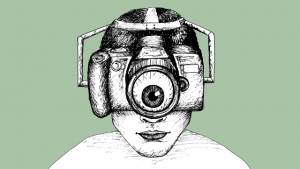The World Health Organisation defines blindness as having visual acuity of less than 20/400. This means that objects visible to the average person from 400 feet are only seen from 20 feet, if at all. Over forty million people worldwide are affected by blindness according to this definition. However, a team led by Dr Eberhart Zrenner, working at the University of Tübingen in Germany, have recently developed a prosthetic chip which could dramatically reduce the numbers of blind sufferers.
Retinitis Pigmentosa and Age Related Macular Degeneration are two of the leading causes of impaired vision. Both of these diseases act by damaging photoreceptor cells on the retina of the eye, preventing the conversion of light into a nervous signal. To compensate for the loss of photoreceptors, synthetic microphotodiodes are implanted into a patient’s retinal photoreceptor layer. In these microphotodiodes, light knocks electrons out of their atomic orbit, generating ‘free electrons’ that can flow, thereby creating a current. By converting light into electric signals, microphotodiodes stimulate bipolar cells (sensory nerve cells) directly, rather than by chemical transmission which our natural photoreceptors use. This allows the signal to be propagated to the visual centres in the brain via the optic nerve. After the implantation of a 3×3 mm array of 1500 microphotodiodes into three trial patients, all regained some sight; they could recognise simple objects such as cutlery and a mug, as well as basic shapes roughly ten centimetres high.
Microphotodiodes, while offering simple solutions to blindness, still have some limitations. Primarily they require the other structures involved in vision, such as the optic nerve, to be functional. Further, while they have much greater acuity than many other visual prosthetics, they still only confer 38×40 pixels of resolution. The resolution of two fully functioning eyes is measured in megapixels.
In order to work around other causes of blindness, different visual prostheses have been proposed, showing amazing variety in their design. Perhaps the most intuitive are a system of cameras with wires that project to artificial electrodes planted on the visual cortex of the brain, directly stimulating the region and producing images. Other prostheses, working by sensory substitution, include a microelectrode array that stimulates the tongue to give an impression of the shape of objects in the visual field. Another technology is the vOICe system, which translates images from a camera on sunglasses into sound that is played into the ear. The visual surroundings are mapped so that the greater the height of an object, the higher the pitch heard and the brighter the object, the louder the sound. After practice, this can give the equivalent of 60×60 pixels of vision. What is perhaps most interesting about these kinds of prosthetics is how their function improves with use, due to neural plasticity—the ability of structure and function of brain regions to change with experience and use. fMRI scans from a study by Dr Amir Amedi and others at the Hebrew University of Jerusalem have shown that the area of the brain that usually responds to vision and touch, is activated in vOICe users’ brains while ‘looking’ at recognisable objects by receiving auditory cues.
Neural prosthetics are still in their infancy, but we should remain optimistic that visual prostheses will soon obtain the acuity of a working visual system. Moreover, future interactions between technology and the nervous system may help to restore function to sufferers of a variety of other disabilities.
Robert Hickman is a 1st year undergraduate reading Physiological Sciences, at St Hugh’s College.
Art by Emma Wilkins.
![For Your Eyes Only The World Health Organisation defines blindness as having visual acuity of less than 20/400. This means that objects visible to the average person from 400 […]](/wp-content/uploads/2011/10/For-your-eyes-only_preview-620x300.png)
